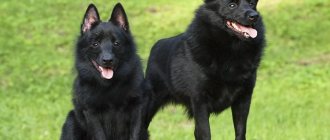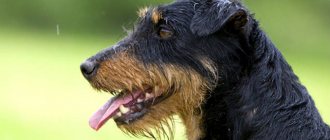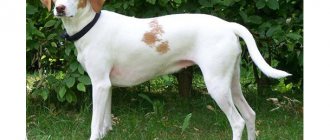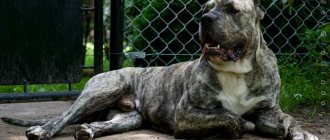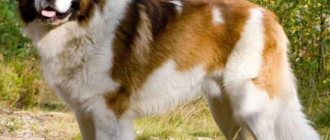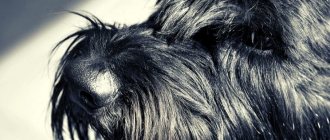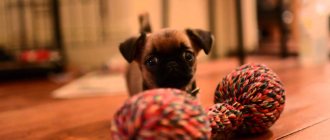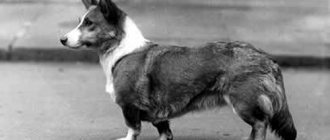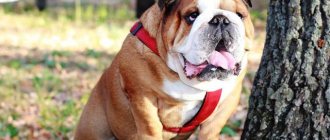Origin story
The place of origin of dachshunds is considered to be Germany. After the standard breed was developed, work was carried out to improve the dogs' hunting skills. Breeders sought to develop a breed of miniature size, so that it would not only be practical for humans, but also have an attractive appearance.
Hare hunting was common in many European countries in the 18th and 19th centuries. Rabbit holes have narrow passages, so the dog had to be able to not only crawl into them, but also move around calmly there. Therefore, breeders from all over Germany set about breeding the optimal dwarf breed.
Among all the varieties obtained, the rabbit (rabbit) dachshund has become the most common among breed connoisseurs. By the end of the 19th century, well-established work on breeding rabbit dachshunds was organized. The work was not easy, since crossing dwarf breeds always produces miniature body sizes. In order for a rabbit dachshund to fully meet the standard, a lot of time and effort had to be spent. The result justified the efforts; representatives of the breed are popular to this day.
Description of the breed
The rabbit dachshund is a miniature dog with short legs, an elongated body, and long ears. The main difference between this variety and standard dwarf dachshunds is the size of an adult dog. The rabbit has a chest girth of up to 30 cm, the standard one – more than 35.
There are three types of rabbit dachshund:
- long-haired;
- wire-haired;
- smooth-haired
Description of appearance is the same for everyone:
- weight of an adult dog – 3-4 kg;
- height – 12-16 cm;
- the head is elongated, the muzzle is narrowed towards the nose;
- large black nose;
- scissor bite;
- ears dropped down, rounded;
- long, straight back;
- toned torso;
- wide chest;
- powerful, muscular legs;
- tail of medium length, pointed.
Stately posture is a feature of the breed. The body looks toned, muscular, there are no folds. If your dachshund is obese, this immediately affects its appearance, and you need to urgently visit a veterinarian.
Colors and coat
The characteristics of the coat depend on its type:
- Smooth-haired. The most common type, in particular demand among lovers of decorative dogs. The coat fits tightly to the body, has a dense structure, and is short in length. Such dogs look attractive, their hairs are similar to velvety fabric that glistens in the sun.
- Long-haired. Rarely used for hunting. Long hairs require special care; they look luxurious and rich. The long-haired rabbit dachshund is an excellent option for a small decorative dog.
- Wirehaired. In our area they are not in great demand; their appearance is less attractive. Connoisseurs of this variety note its funny appearance; the long beard looks outstanding. The coat is thick, bristly-like, thanks to it dogs can survive in harsh conditions - excellent for hunting.
The acceptable color of the rabbit dachshund varies. They can be one-color, two-color, mixed. The first two types are most common; the solid color usually has a red tint. Two-tone coloring is also common, when the main color is black or brown, it is complemented by tan marks of other shades.
Mixed color implies the presence of many colors: black, brown, gray, red; the spots should not be large. Such representatives of the breed are rare.
Breed standard
According to the standard, representatives of the rabbit dachshund breed must have certain external features. Breed Features:
- The head is proportional in size, shaped like an elongated wedge. The forehead is almost flat, the back of the head is clearly defined. The muzzle tapers, but is not pointed.
- Jaws – powerful, lock-shaped bite. The teeth are complete, the canines close together tightly, and the incisors are on parallel lines.
- The nose is sensitive, most often black.
- The eyes are oval-shaped, with an expressive look.
- The ears are in the shape of a triangle, the edges are rounded.
- The neck is elongated and curved, which gives the stance a proud look.
- Body – the body is elongated, muscular, but compact. The loin is strong and long, the croup is sloping but not steep.
- The limbs are smooth and set straight. On the front paws, it is permissible to bring the wrists closer together.
- The tail is standard length, medium thickness. The tail must be straight, however, a sickle shape is acceptable.
Wool
According to the type of fur, rabbit dachshunds are:
- Smooth-haired. The length of the hairs does not exceed 1 cm, fits tightly to the body, but is not coarse.
- Long-haired. The hair on the body, limbs and ears is wavy, its length is from 5 to 10 cm, so we can safely say that this is more of a curly dachshund. The long-haired rabbit dachshund has a beautiful appearance.
- Wirehaired. The length of the coat is up to 3 cm, wiry, thick and dense. For this variety, the formation of eyebrows, mustaches and beards is important.
Important! In nurseries, rabbit wire-haired dachshunds are most often found, followed by the curly-haired dachshund.
Long and active walks are vital for your pet.
Color
The main colors of pets are:
- black and tan;
- red or golden;
- brown and tan;
- brindle;
- marble.
Disqualifying faults
For the wire-haired type, the boar color is acceptable, however, for pets with a different type of coat, this is a noticeable drawback.
Character
Representatives of the breed are companions for the owner and his family. Dachshunds are perfect for living in a large family with children, for one person, or for the elderly. If there is a child in the house, the pet will become for him, on the one hand, a toy, a partner in fun, amusement, and on the other, a protector, nanny, and security guard. However, Dachshunds will not tolerate bad treatment. If children and adults treat them inappropriately, the animals will not tolerate it. They will definitely fight back either with their behavior or even with aggression.
Distinctive character traits are activity, energy, and curiosity. If you plan to keep your dog alone within four walls all day, it is better to choose a different breed. Bonded to people, cheerful dachshunds will not survive in such conditions. They experience a long separation from their owner especially acutely.
The hunting skills of the representatives of the breed, which are in their blood, periodically make themselves felt even to dogs that have lived their entire lives as decorative pets. If a rodent or other small animal runs nearby, the dachshund will immediately react and be ready to chase it.
The hunting instincts of the rabbit dachshund prevent it from living peacefully in the same house with other animals, especially rodents. Small puppies can play with them, and over time they will begin to see them as their target.
The mini rabbit breed is small in size and weight. Despite this, the pet is always ready to defend its owner and his property when danger arises. The guarding instinct appears in puppies immediately after birth. High intelligence does not allow them to behave inappropriately. They will never attack first or show causeless aggression.
Character and qualities
The rabbit dachshund was originally created for hunting burrowing animals. More plays the role of a decorative companion dog.
The breed is characterized by the following qualities:
- Equilibrium;
- Energy;
- Courage;
- Curiosity;
- Intelligence;
- Developed sense;
- Endurance;
- Cleanliness;
- Stubbornness.
Thoroughbred individuals have a strong nervous system. They show aggression only towards hunting objects. They treat adults and children friendly, but treat strangers in the house with a degree of suspicion. They do not have the habit of barking and biting for no reason.
The dog is distinguished by its mobility and has a large supply of energy. The child will be able to arrange active games with the pet. The dachshund will enjoy spending time with the baby. If there are no children in the family, then the owner will have to devote a lot of time to playing with the dog. Otherwise, the dog will start making a mess out of boredom. Lack of attention leads to problems in the animal's behavior.
Like all hunting breeds, the dachshund has courage and determination. He will not be afraid to enter into an unequal battle with a large animal.
Curiosity makes the dachshund seek new experiences. The dog willingly gets acquainted with new surroundings, so it quickly adapts to the environment.
Natural intelligence makes the individual cunning and calculating. The pet will find an approach to every family member. It is important not to give the dog any concessions, otherwise the animal will become capricious and disobedient. Dachshunds are capable of learning at any age. Training brings more results if it begins when the puppy is very young.
Individuals have a hunting sense, acute hearing, and developed intuition. The dachshund can be used as a watchdog.
Thoroughbred representatives have strong immunity and endurance. Due to the specific structure of the spine, they may have problems with the musculoskeletal system. To maintain health they need long walks.
These dogs quickly become accustomed to order, carefully lick their fur, will not intentionally mark in the house, and can be trained to use the litter box for needs. Caring for animals is not difficult; they can be kept in apartments.
There are representatives with a stubborn character. Dachshunds can be touchy, vindictive, and do not tolerate rudeness. The owner should not be cruel to the animal; it is better to punish the pet for its misdeeds by ignoring it. The dog will sense a change in the owner’s behavior in order to regain his favor and become more flexible. To ensure that the owner’s reputation is not lost, socialization and training of the pet must begin from the moment it appears.
Care and maintenance
Like any other breed, dachshunds require special rules for care and maintenance. The animal's fur needs regular brushing. Haircuts are rarely done; usually a trimming procedure, offered in many salons, is sufficient. Wire-haired representatives of the breed especially need it.
Bathing is extremely rare. Until the age of six months, it is recommended to avoid contact with water; after that, water procedures are performed as necessary. The skin of a rabbit dachshund is very delicate, so it is important to buy shampoos for gentle washing, using massaging, gentle movements when lathering. The water should be at room temperature; too warm will cause discomfort.
Trimming claws is a prerequisite for keeping an animal. It can be done at home by purchasing special nippers. The first procedure for trimming claws is best done in a salon, watching the master work.
Caring for your pet also includes daily examination of the ears and teeth. If inflammatory processes occur, you should immediately contact a veterinarian. If your pet regularly has health problems affecting these organs, the doctor may prescribe the use of antiseptic and other agents on an ongoing basis.
Feeding
The main rule when choosing a diet for a pet is that the food should be healthy and nutritious. The easiest way is to buy ready-made food of high quality, containing useful components in sufficient quantity for the dog. It’s easy to calculate the quantity; you must follow the manufacturer’s recommendations.
If you decide to cook for your pet yourself, the rule about choosing nutritious food is also relevant. Only fresh or properly stored products should be used. You should decide on the choice of food before the puppy arrives in the house, so that he immediately gets used to it.
Dachshunds are not picky when it comes to food. Unlike many breeds, they enjoy eating raw and stewed vegetables.
The list of permitted products is extensive:
- several types of lean meat;
- fish (a couple of times a week);
- cereals, pasta;
- boiled eggs;
- dairy products;
- vegetables fruits;
- bread (occasionally).
The following are strictly prohibited for use:
- pork;
- confectionery;
- fried, fatty, spicy foods;
- too salty food;
- smoked meats, sausages;
- boiled bones.
The pet should be switched to two meals a day by the age of 8 months. The optimal feeding time is after a walk, then the dachshund should lie down; active activities immediately after eating are contraindicated. It is advisable to feed your pet at the same time every day. The dog should always have access to clean water.
Care
The description of caring for a long-haired dachshund does not differ so significantly from smooth-haired and wire-haired ones. The rabbit dachshund does not require complex or special care, the main thing is not to forget about the need to get vaccinations on time.
- You should not bathe often, until 6-8 months it is advisable not to bathe at all, limit yourself to washing your paws only
- Nails must be trimmed regularly, for long-haired and wire-haired dogs - with caution, hair can interfere with the process and you can inadvertently injure the dog.
- Pay attention to the eyes, especially in long-haired and wire-haired dachshunds, the eyes should be clean and free of discharge.
- For a short-haired representative of the breed, it is enough to brush it once a week and wipe it with a damp cloth after a walk.
- A wire-haired dachshund should have its hair cut twice a year and periodically brushed. But the long-haired dachshund requires frequent and thorough combing, periodic bathing and professional grooming.
- Wire-haired and long-haired dachshunds need a thorough examination of their coat after a walk; a dog can bring anything in it, given its energetic character and hunting instinct; after running through the bushes and chasing squirrels and pigeons, sticks, leaves, chewing gum, burrs and much more.
- Do not forget to inspect the oral cavity for damage to teeth and odor. The ears should also not escape your attention, especially if the dachshund is wire-haired or long-haired.
- Rabbit dachshunds are great at litter box training, they are very neat, but don’t forget about full walks.
Training and education
After the puppy arrives in the house, it is important to teach him:
- Respond to name. This usually takes no more than a few days. Popular nicknames for boys are Archie, Freddie, Charlie, for girls - Baby, Tina, Lana. You need to make your choice before the puppy arrives in the house, so that you can immediately handle it correctly.
- Know your place. To make it easier for the puppy to remember its place, it should be as comfortable as possible. It is necessary to use new, clean bedding and create all conditions for the pet to spend time normally. It is advisable to immediately present the dog with a toy, luring it to its place.
After that, start learning basic commands. The easiest way to do this is when the vaccinations are done, you can take your pet for walks. It is important to maintain consistency; you cannot call the command in different words, for example, if the prohibiting command is “fu”, ordering “no” is pointless, the animal will only get confused. Dachshunds are easy to train, so after basic commands you can train using any of the available programs. It is best to contact dog handlers.
Diseases and life expectancy
The average life expectancy of representatives of the breed is 12-15 years. In many ways, this period depends on the conditions of detention, timely implementation of vaccinations, and proper attention during old age. Several times a year, a pet of any age should be shown to a veterinarian.
The lifespan of rabbit dachshunds also depends on gender (girls live longer), lack of stress, and compliance with hygiene rules.
Genetic features of the body structure and internal organs of dachshunds cause the following diseases:
- obesity;
- ear diseases;
- joint inflammation;
- spinal dysplasia.
Small stature and a long body look attractive, but can become a provoking factor for the development of these other diseases. It is strictly forbidden for dachshunds to jump from heights, even small ones, as they are susceptible to injury. For any bruise or dislocation, you must contact a veterinarian.
Hygiene
Caring for an animal's fur is of particular importance. A smooth-haired pet is combed with a brush from time to time, a long-haired pet is not only combed, but also trimmed once every six months, and a wire-haired pet is taken for trimming instead of a haircut.
The pet's ears and mouth are examined daily and cleaned when dirty. The eyes are wiped with a cotton swab dipped in boiled water. The claws are trimmed with a special nail clipper if they do not grind down on the asphalt on their own during a walk.
You should care for your dog carefully and attentively, and at the first signs of illness, immediately contact a veterinarian
Pros and cons of the breed
The following are the advantages and disadvantages of the breed:
| + | — |
| Attractive appearance | Need for long daily walks |
| Hunting, guarding, defensive skills | It is important to strictly monitor your weight |
| Inconsistency in food | Wool needs protection when walking |
| They love children and maintain good relationships with all family members. | Doesn't get along well with other pets |
| Easy to learn, quickly remember basic commands, can master special programs | They do not tolerate bad treatment; if a child offends them, they can become aggressive |
| With proper care they have a long life expectancy |
Where to buy and price
The average price for representatives of the breed with documents is 15,000-25,000 rubles. It depends on the color and type of coat. It is not difficult to find a nursery offering representatives of the breed; CERTUS, Emerald Fairy Tale, Kinchville, and others are popular. Buying a puppy without documents from an unverified place is risky.
The rabbit dachshund is a small dog with a bright, eye-catching appearance. Today it is more used as an ornamental breed rather than a hunting breed, but courage and agility are innate qualities. A dachshund will not be able to live alone, if you devote time and effort to it, it will become a true four-legged friend for the whole family. She will be especially comfortable among a large family with children.

